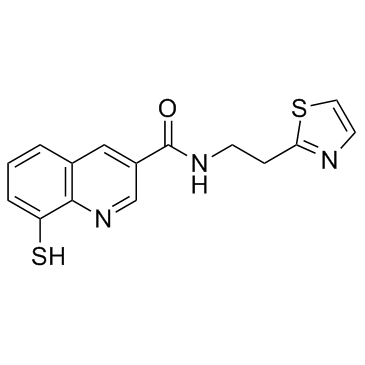| Description |
Rpn11-IN-1 is a potent and selective inhibitor of proteasome subunit Rpn11 with an IC50 of 390 nM.
|
| Related Catalog |
|
| Target |
IC50: 390 nM (Rpn11)[1]
|
| In Vivo |
Rpn11 is a Zn2+-dependent metalloisopeptidase that hydrolyzes ubiquitin from tagged proteins that are trafficked to the proteasome for degradation. When inhibition of Rpn11-IN-1 (Compound 35) against Rpn11 is measured in the presence of Zn(cyclen)2+ (100 μM), a significant loss in activity against Rpn11 is observed (IC50=77.4 μM vs. 0.39 μM). The observed IC50 value shift is attributed to the ability of Zn(cyclen)2+ to compete/titrate Rpn11-IN-1 away from Rpn11. Rpn11-IN-1 blocks proliferation of tumor cells in culture. Rpn11-IN-1 has an IC50 of 2.1 μM and 3.8 μM against 293T and A549 cells, respectively[1].
|
| Cell Assay |
293T, A549 and HCT 116 cell lines are cultured in DMEM with 10% FBS in white, clear-bottom tissue culture-treated 96-well plates. Cells are treated with different concentrations of inhibitor compounds (e.g., Rpn11-IN-1; 0.01, 0.1, 1, 10, and 100 μM) in triplicates for 72 h at 37°C with 5% CO2 in air. CellTiter-Glo reagent is added to the 96 well plates to measure cell viability. Luminescence values are measured in PHERAstar microplate reader. Collected data is normalized to DMSO control and fit to a dose-response equation to determine IC50 values[1].
|
| References |
[1]. Perez C, et al. Discovery of an Inhibitor of the Proteasome Subunit Rpn11. J Med Chem. 2017 Feb 23;60(4):1343-1361.
|
